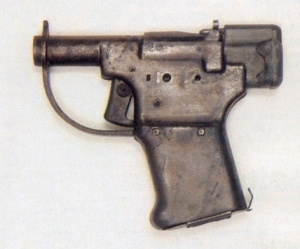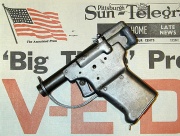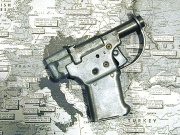Sandbox
- This article is about the American WW2 insurgency weapon. For the shotgun, see Winchester Liberator; for the 3D printable pistol, see Defense Distributed Liberator.
| The Liberator | |
|---|---|

| |
| The FP-45/M1942 | |
|
| |
| Type | single shot pistol |
| Land of Origin | United States |
| Specifications | |
| Frame | stamped sheet metal |
| Length | 5.55 in (141 mm) |
| Barrel length | 4 in (100 mm) |
| Weight | 1 lb (450 g) |
| Cartridge | .45 ACP |
| Chambers | 1, conical |
| Rifling/Twist | none |
|
| |
| Rate of Fire | (maybe) 6 RPM |
| Muzzle velocity | 820 ft/s (250 m/s) |
| Max. Range | 8 yd (7.3 m) |
| Feed | Single-shot |
| Sights | iron sights so crude they may as well have not even been there. |
| Service History | |
| In service | 1942–1945 |
| Used by | Dropped into occupied territories for use by insurgents |
| Wars | World War II |
| Production History | |
| Designer | George Hyde[1] |
| Design Date | May 1942[1] |
| Manufacturer | Guide Lamp Corporation of General Motors[1] |
| Unit Cost | $2.10 (1942)[1] |
| Produced | June – August 1942[1] |
| No. Built | 1,000,000 |
Contents |
Project History
The concept was suggested by a Polish military attache in March 1942. The project was assigned to the US Army Joint Psychological Warfare Committee and was designed for the United States Army two months later by the Inland Manufacturing Division of the General Motors Corporation in Dayton, Ohio. Production was undertaken by General Motors Guide Lamp Division to avoid conflicting priorities with Inland Division production of the M1 carbine.[1] The army designated the weapon the Flare Projector Caliber .45, hence the designation FP-45. This was done to disguise the fact that a pistol was being mass produced. The original engineering drawings label the barrel as "tube", the trigger as "yoke", the firing pin as "control rod", and the trigger guard as "spanner".
The Guide Lamp Division plant in Anderson, Indiana assembled a million of these weapons. The Liberator project took about 6 months from conception to end of production with about 11 weeks of actual manufacturing time, done by 300 workers. Using that figure, 300 people produced a pistol with 23 parts every 6.6 seconds, 24 hours a day, 7 days a week, for 11 weeks — making it probably the only pistol in the entire history of gunfire that could be manufactured faster than it could be loaded. Loading this clunker takes about 10 seconds.
Concentration camps
Contrary to popular myth, the Liberator was never intended to be dropped on concentration camps with the bizarre notion that internees would pick up the weapons, overcome Nazi Guards, and liberate the camp.
Forgetting, for the moment, the flummoxingly ludicrous notion that a group of half-starved civilians with crude single shot weapons would somehow be able to overcome a trained military force complete with SMGs, machine gun towers, and all the other then-state-of-the-art German equipment, the horrors of the "final solution" were considered nothing more than wild rumors in the early years of the war — useful for propaganda purposes but not considered reliable intelligence. Such barbarity was considered to be simply too inhuman to have actually been committed, even for the Germans.
It was not until advancing Allied forces began liberating the camps, beginning with the nearly intact capture of Majdanek (Konzentrationslager Lublin) in July 1944, that Allied Command began to realize the true scale of the Nazi atrocities.[2]
Design
The FP-45 was a crude, single-shot pistol designed to be cheaply and quickly mass produced. The Liberator had just 23 largely stamped and turned steel parts that were cheap and easy to manufacture. It fired a .45 caliber pistol cartridge from an unrifled barrel. Due to the lack of rifling, it was intended for very close ambush, 1–4 yd (also known as "spitting distance"). Its maximum effective range was only about 25 ft (7.6 m). At longer range, the bullet would begin to tumble wildly and stray off course. The weapon's conical, rather than straight, chamber didn't help matters either, as it allowed lateral play of the loaded round (this feature could perhaps be considered an asset when loading the weapon in dirty field conditions, but it does nothing for accuracy).
Another issue is excessive headspace, up to .020” free play between the cover slide and the breech end of the barrel.
Every FP-45 that left the factory for service was tested once and some were test fired 50 times to the point they were deemed unserviceable as a part of the quality control process[3]. Because of the low quality, it was nicknamed the "Woolworth gun."- Liberator pistol.png
An extremely simple gun.
Safety

It is our position at Vintage Ordnance that it is flatly unadvisable to fire any original FP-45 Liberator Pistol because of some inherent weaknesses related to their design that could result in damage to the weapon and injury or death to the shooter or others in the vicinity. In addition, compared to modern arms of the same era, FP-45s appear to be more likely to accidentally discharge if jarred or dropped while cocked or carried with the cocking piece resting on a chambered round. (A Vintage Ordnance replica made in 2009 would share this in common with a 67 year old original.) 
— Vintage Ordnance Co. LLC
Wartime use
The Liberator was shipped in a cardboard box with 10 rounds of .45 ACP, a wooden dowel to poke out the empty cartridge case (think of a ramrod packing a musket), and a comic strip instruction sheet[4] showing how to load and fire the weapon. Extra rounds of ammunition could be stored in the pistol grip. The Liberator was a crude and clumsy weapon, never intended for front line service. It was originally intended as an insurgency weapon to be mass dropped behind enemy lines to resistance fighters in occupied territory. The notion was that a resistance fighter would to recover the weapon, sneak up on an Axis occupier, kill or incapacitate him, and snatch up his (much better) weapons.[5]
The weapon was valued more for its psychological warfare effect as its actual field performance. It was thought that if an unholy buttload of these weapons could be delivered into Axis-occupied territory, it would have a devastating effect on the morale of occupying troops. The plan was to drop the weapon in such great quantities that occupying forces could never capture or recover all of them. It was hoped that the thought of thousands of these unrecovered weapons potentially in the hands of the citizens of occupied countries would have a deleterious effect on enemy morale.[6]
General Eisenhower's staff, however, were more realistic and never saw the practicality in mass dropping the Liberator over occupied Europe, and authorized distribution of fewer than 25,000 of the half million FP-45 pistols shipped to Great Britain for the French resistance. Generals Joseph Stillwell and Douglas MacArthur were no more enthusiastic about the other half of the pistols scheduled for shipment to the Pacific. The Army then turned 450,000 Liberators over to the Office of Strategic Services. Resistance fighters in both theatres were supplied with more effective weapons whenever possible, and French use of the FP-45 remains completely undocumented; although OSS did distribute a few to Greek resistance forces in 1944. 100,000 FP-45 pistols were shipped to China in 1943, but the number actually distributed remains unknown. A few were distributed to Philippine troops under the Commonwealth Army and Constabulary and resistance fighters.[1]
Firearms collectors
The original delivered cost for the FP-45 was US$2.40/unit[4] ($33.35 in 2012, adjusted for inflation). A Liberator in good condition today can fetch approximately $1200, with the original box bringing an additional $500. Add in an original extremely rare paper instruction sheet and the value could rise above $4500 to a collector of rare World War II militaria. Fakes of these sheets exist, but authentic copies have a watermark that can be seen clearly, which has proven extremely difficult for counterfeiters to duplicate.
The Concept Revived
The Liberator was replaced with the Deer gun in 1964 when a "modernized" (if you can call it that with a straight face) equivalent was designed for possible use in Vietnam.[4] This was because the CIA needed a weapon of this type and most of the Liberators, considered by the military to be the next best thing to useless, had been scrapped after World War II.
The Deer Gun was chambered for 9x19mm Parabellum and was loaded by unscrewing the barrel and inserting the next round to fire. Spray and pray, baby; spray and pray.
References
- ↑ 1.0 1.1 1.2 1.3 1.4 1.5 1.6 1.7 Bruce N. Canfield "Desperate Times: The Liberator Pistol" American Rifleman August 2012 pp.48-51 & 83-84
- ↑ C. Peter Chen "Discovery of Concentration Camps and the Holocaust: 24 Jul 1944 - 29 Apr 1945" World War II Database
- ↑ Ralph Hagan, The Liberator Pistol, Development, Production, Distribution. 1996
- ↑ 4.0 4.1 4.2 Bishop, Chris (2006). The Encyclopedia of Small Arms and Artillery. Grange Books. p. 19. ISBN 978-1-84013-910-5.
- ↑ Riiiight... great idea, guys.
- ↑ Wolfgang Michel: Die Liberator Pistole FP-45: Partisanenwaffe und Instrument der psychologischen Kriegsführung. ISBN 978-3-8370-9271-4
External links
- The Liberator Pistol at JustGuns.com<
 dead link >
dead link >
- "Safe handling of Liberator pistols and modern replicas". Vintage Ordnance Company.
- The Liberator Pistol, by Ralph Hagan




